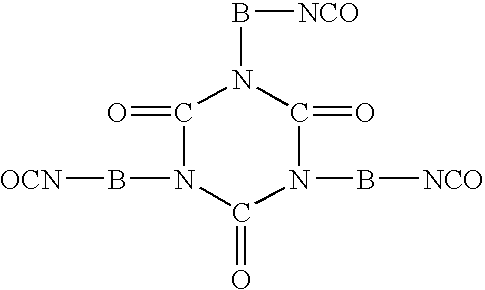Hydrophilic stain release agents
- Summary
- Abstract
- Description
- Claims
- Application Information
AI Technical Summary
Benefits of technology
Problems solved by technology
Method used
Image
Examples
example 1
[0045] A three-neck, 1 L round-bottom flask was equipped with a reflux condenser with a nitrogen inlet, a temperature probe, an addition funnel, and a TEFLON-coated magnetic stirring bar. The reaction vessel was charged with methoxy polyethylene glycol 750 (45 g, 60 mmol), 3,3,4,4,5,5,6,6,7,7,8,8,8-tridecafluorooctan-1-ol (41.7 g, 115 mmol) and DESMODUR N100 (82.3 g, 63% in methyl isobutyl ketone (MIBK), 270 mmol). The colorless reaction mixture was heated to 65° C. until the temperature stabilized. To this, 3.3 g of Tyzor TPT solution (5% Tyzor TPT in MIBK) was added slowly through the addition funnel, followed by stirring at 95° C. for 3 hours. To the flask, 40 g MIBK and 16 g water was added and the temperature was held at 75° C. for 4 hours. An additional 295 g of water was added and the mixture was stirred at 78° C. for 30 minutes or until no isocyanate was detected. The solution was homogenized using a digital sonifier for 5 minutes and MIBK was removed via vacuum distillation...
example 2
[0047] The procedure of Example 1 was employed except for using 3,3,4,4,5,5,6,6,6-nonafluorohexan-1-ol (30.2 g, 0.115 mol) in place of 3,3,4,4,5,5,6,6,7,7,8,8,8-tridecafluorooctan-1-ol. The resulting dispersion was 33.4% solids and 4.26% Fluorine.
[0048] The dispersion was applied to 100% cotton fabric using Test Method 1. The fabric was evaluated for wicking using Test Method 2, stain release using Test Method 3, and durability using Test Method 4. Results are listed below in Table 1.
example 3
[0052] A three-neck, 1 L round-bottom flask was equipped with a reflux condenser with a nitrogen inlet, a temperature probe, an addition funnel, and a TEFLON-coated magnetic stirring bar. The reaction vessel was charged with 3,3,4,4,5,5,6,6,6-nonafluorohexan-1-ol (1.52 g, 5.77 mmol), 3,3,4,4,5,5,6,6,7,7,8,8,8-tridecafluorooctan-1-ol (2.1 g, 5.77 mmol), methoxy polyethylene glycol 750 (4.5 g, 6.0 mmol), 0.3 g of the Tyzor TPT solution catalyst, and DESMODUR N100 (8.2 g, 63% in MIBK, 27 mmol) were used. The reaction was heated for 3 hours at 95° C. After the deionized water was added (1.6 g. 89 mmol) the reaction was heated at 95° C. until there was no isocyanate present, as detected using a Colormetric Technologies, Inc isocyanate test strip—the solution was heated for 7 hours and an additional 12 hours at 75° C. Homogenization was performed as described in Example 1 giving a final product that was 15.7% solids and 3.08% F.
[0053] The dispersion was applied to 100% cotton fabric usin...
PUM
| Property | Measurement | Unit |
|---|---|---|
| Fraction | aaaaa | aaaaa |
| Fraction | aaaaa | aaaaa |
| Fraction | aaaaa | aaaaa |
Abstract
Description
Claims
Application Information
 Login to View More
Login to View More - R&D
- Intellectual Property
- Life Sciences
- Materials
- Tech Scout
- Unparalleled Data Quality
- Higher Quality Content
- 60% Fewer Hallucinations
Browse by: Latest US Patents, China's latest patents, Technical Efficacy Thesaurus, Application Domain, Technology Topic, Popular Technical Reports.
© 2025 PatSnap. All rights reserved.Legal|Privacy policy|Modern Slavery Act Transparency Statement|Sitemap|About US| Contact US: help@patsnap.com



